
WASHINGTON D. C. GEOMETRY

Johnson's Georgetown and the city of Washington
The island known today as Roosevelt Island (due west of the White House in the middle of the Potomac) was called Mason's Island until early in the 20th century. George Mason originally owned the island and he built a bridge from the Virginia side. He had a large retreat house on the island where he entertained friends and guests. George Washington was a neighbor and very good friend of George Mason. Mason was the author of the Virginia Bill of Rights, which became the U. S. Bill of Rights when it was added as the first ten amendments to the constitution of the U.S. There is some evidence that George Mason was a Mason, but it is not certain. Extending New Hampshire Avenue to the southwest, into the Potomac, it crosses over the southern tip of Mason's Island. The Masonic Headquarters of the Scottish Rites of the 33rd degree is just south of the point where New Hampshire Avenue crosses 16th Street, due north of the White House.
Highlighted below are Massachusetts and Connecticut Avenues radiating from the upper left circle, Rhode Island and Vermont Avenues radiating from the upper right circle, and the horizontal street is K street. The White House is located at the apex of the pentagram.
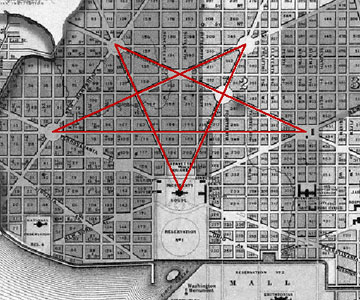
Highlighted below are Massachusetts Avenue and 19th Street radiating from the upper left circle, Rhode Island Avenue and 13th Street from the upper right circle, New York Avenue and 19th Street from the lower left square and Pennsylvania Avenue and 13th Street from the lower right square. The White House is located at the lower intersection point of the two large triangles that form the Hexagram.
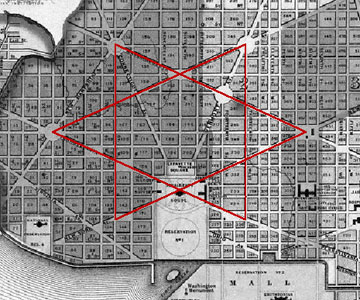
The pentagram and the hexagram are perfectly integrated with the White House in the layout of Washington D.C.
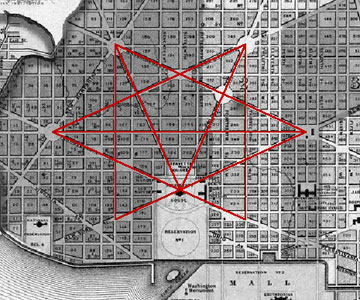
Below is a diagram of a pentagram drawn into a true hexagram. Each of the six lines that form the hexagram are three inches long and each of the short segments of the hexagram are one inch long.


One is also the square root of one and three is the square root of nine. The distance between the adjacent outer points of the hexagram is 1.732 inches (AB, AC, BD, etc.) 1.732 is the square root of three. HD and all of the other segments that are comprised two of the short segments of the hexagram are two inches long. The distance HE is also two inches long. Two is the square root of four. The two diagonal lines of the pentagram (AE and BE) are 2.646 inches long. 2.646 is the square root of seven. The horizontal line of the pentagram (CD) is 3.464 inches long. 3.464 is the square root of 12.
The segment FH in the hexagram is bisected at G by the line AE of the pentagram. The proportion FG : GH is 1 : 2. The proportions of the segments in the entire line CB are as follows:
CF : FG : GH : HB = 3 : 1 : 2 : 3
The proportions of the line AE as bisected by the lines of the hexagram and the pentagram are as follows:
AG : GJ : JE : = 5 : 4 : 6
The proportions of the line CD as bisected by the lines of the hexagram and the pentagram are as follows:
CI : IJ : JK: KL : LD = 5 : 3 : 4 : 3 : 5
In the diagram below, points J and K from the diagram above are the centers and the segment JK is the radius of two circles, forming a vesica pisces that is perfectly inscribed by the four diagonal lines of the hexagram.

The intersection point of the two circles (M) and the two intersection points of the hexagram diagramed below (N and O) form a triangle with angular dimensions nearly identical to the Great Pyramid of Giza.

In the diagram below, a hexagram is drawn into a true pentagram. All five of the lines that form the pentagram are 1.618 inches long. The distance between all of the adjacent outer points of the pentagram, and all of the adjacent outer points of the hexagram, is one inch. The φ proportion is 1.618 to one.

All of the lines of the pentagram are divided into three segments by the other lines of the pentagram. Each line is divided as follows:
.618 : .372 : .618
.618 /.372 = 1.618
.618 + .372 = 1
1/.618 also equals 1.618
The length of the vertical lines in the hexagram are 1.902 inches long. The vertical lines are divided by the intersections of the diagonal lines as follows:
.7265 : .449 : .7265
.7265/.449 = 1.618
.7265 + .449 = 1.1755
1.1755/.7265 also equals 1.618.
All of the isosceles triangles in the hexagram have an apex angle of 72° and base angles of 54°. Bisecting these isosceles triangles forms 36° - 54° - 90° right triangles. This particular right triangle was an important geometric form known as the mr triangle in ancient Egypt.
As shown in the diagram above, all six of the outer points of the hexagram are perfectly inscribed by a vesica pisces.
The pentagram and the hexagram are also combined in the Great Seal of the United States, displayed on the back of one dollar bills.
 .
.
The traditional explanation of the 13 stars is the same as the 13 arrows and the 13 leaves and berries on the olive branch, representing the 13 original states, but the arrangement of the 13 five pointed stars forms a hexagram.
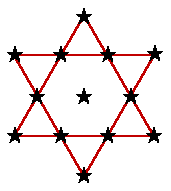
The truncated pyramid below the eye on the reverse side of the Great Seal is also comprised of 13 courses of masonry. A 13 stepped truncated pyramid is also on top of the Masonic headquarters on 16th Street in Washington D.C.
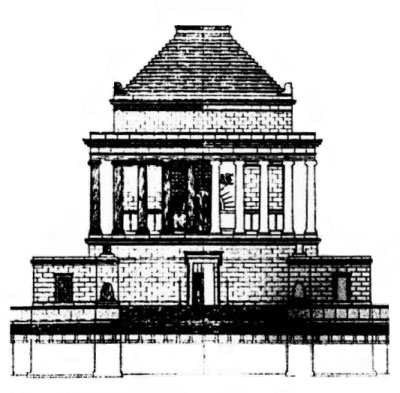
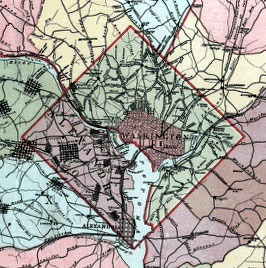
James Clements' map of Washington City
The length of the north-south and east-west diagonals is ten miles times the square root of two, or 14.142 miles. This distance converts to 43,455 ancient Egyptian royal cubits, the same figure as the ratio between the Great Pyramid and the dimensions of the earth. The height of the Great Pyramid is 481.13 feet, divided by 5280 equals .0911231 miles. The mean radius of the earth is 3,960 miles, divided by .0911231 equals 43,457. The perimeter of the Great Pyramid is 3023 feet, divided by 5280 equals .5725 miles. The mean circumference of the earth is 24,880 miles, divided by .5725 = 43,458.
3960 miles (radius of the earth) divided by 14.142 miles = 280 (number of cubits in the height of the Great Pyramid)
24,880 miles (circumference of the earth) divided by 14.142 miles = 1,760 (cubits in the perimeter of the Great Pyramid)
Converting the radius and circumference of the earth to cubits yields the same results:
3,960 miles times 5,280 = 20,908,800 feet divided by 1.718 = 12,170,430 (earth radius in ancient Egyptian cubits)
12,170,430 cubits divided by 43,455 cubits = 280 cubits
24,880 miles times 5,280 = 131,366,400 feet divided by 1.718 = 76,464,726 (circumference in ancient Egyptian cubits)
76,464,726 cubits divided by 43,455 cubits = 1,760 cubits